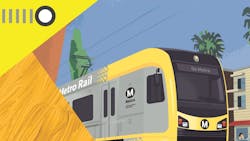L.A. Metro Board approves final EIR for Eastside Transit Corridor Phase 2 Project
The Los Angeles County Metropolitan Transportation Authority (L.A. Metro) Board has voted to approve certification of the final Environmental Impact Report (EIR) for the Eastside Transit Corridor Phase 2 Project. The approval finalizes the EIR for the two-phased project that will extend the L.A. Metro E Line nine miles further east from its current terminus at Atlantic Station in east Los Angeles, Calif., to Lambert Station in the city of Whittier.
"L.A. Metro is continuing to take steps to expand the system to reach more of the Los Angeles region and improve connections within the county while we urgently work to make sure L.A. Metro existing riders feel safe on the system," said Los Angeles Mayor and L.A. Metro Board Chair Karen Bass. "The extension of the L.A. Metro E Line will bring jobs, accessibility and opportunity to many more Angelenos and we look forward to that progress."
As part of Phase 1 that is scheduled to start by 2029, according to the Initial Operating Segment (IOS), the line will extend from Pomona and Atlantic Boulevards to the city of Whittier via Washington Boulevard. The Eastside Extension will include three new rail stations, with the new Atlantic/Whittier and Commerce/Citadel stations underground and the Greenwood station at street level. Additionally, a new Maintenance and Storage Facility will also be added and located in the city of Montebello.
"The Eastside has been waiting many decades for this extension," said Los Angeles County Supervisor First District and L.A. Metro Board Member Hilda L. Solis. "Extending the E Line from East LA to Whittier will offer access to jobs — including the creation of as many as 16,000 good-paying union jobs in construction — educational opportunities and housing, which will deliver economic benefits to many of our most vulnerable residents. I am delighted to celebrate this milestone and look forward to continuing the work to improve transit connectivity for our Eastside communities."
"Whether it’s for school, work, shopping or a night out, people are already on the move every single day between the Westside and downtown LA and the eastern communities I represent like Commerce, Pico Rivera, Santa Fe Springs and Whittier but what they haven’t had is a fast, affordable single-seat ride to get where they’re going. With the board’s support for this project, today we are on the path to making the Eastside Extension to Whittier a reality and transforming how so many people in these communities move," said Los Angeles County Board Supervisor and L.A. Metro Board Member Janice Hahn.
The Eastside Transit Corridor Phase 2 rail extension will provide commuters in a high travel-demand corridor relief to the limited transportation systems currently available.
The initial segment from east Los Angeles to Greenwood Station in Montebello will include approximately three miles of light-rail transit underground, a half mile of aerial transit and 1.1 miles of track at street level, for a total of 4.6 miles of new rail line from the current terminus at Atlantic Boulevard.
"I think it's important to note that the construction and operation of the entire project is expected to create 1,500-1,600 jobs and generate $1 billion per year in economic activity for the region," said L.A. Metro Board Member Fernando Dutra. "I am looking forward to the good paying construction jobs that will be created by this project."
L.A. Metro engaged with communities throughout the environmental study and the project team will continue to coordinate with cities, property owners, third party utility owners and other key local, state and federal agency stakeholders as the project develops throughout the design and re-initiating the National Environmental Policy Act.
"When this new section of the E Line opens, L.A. Metro riders in our eastside communities will be connected to the greater network of transit throughout the L.A. Metro system," said L.A. Metro CEO Stephanie Wiggins. "Added connectivity for all communities throughout Los Angeles County is a priority for L.A. Metro."
Funds for phase 1 of the project comes from the Measure M transportation sales tax measure approved by voters in 2016. Measure M allocates $6 billion for this project in two funding cycles. Cycle 1 allocates $3 billion for the Washington Alternative beginning in 2029 and Cycle 2 allocates $3 billion for the second alternative beginning in 2053. The second alternative is being evaluated through the San Gabriel Valley Transit Feasibility Study.
More information on the project can be found on L.A. Metro’s website.
